The Microsoft Surface Laptop Studio Review: Dynamic Design
by Brett Howse on October 5, 2021 9:00 AM EST- Posted in
- Laptops
- Microsoft
- Surface
- Surface Laptop Studio
Display Analysis
If the Surface Laptop Studio is the successor to the Surface Book, it has a lot to live up to in the display department. Microsoft is dubbing their new display the PixelSense Flow display, and that is because it now offers a 120 Hz refresh rate. Advantage Laptop Studio. The 120 Hz option can be disabled to save power, but even if left in the default 120 Hz mode, the laptop will automatically lower the refresh rate when it can to limit the power usage. I have been fortunate enough to use a lot of high refresh rate displays over the years, and the additional smoothness in all tasks is very welcome.
One area where the 14.4-inch Laptop Studio falls a bit short compared to the Surface Book is pixel density. The 2400x1600 3:2 aspect ratio display comes in at 201 pixels per inch, compared to 260 pixels per inch on the Surface Book 3. Though slightly less sharp, it is still a high-PPI display, and the lower resolution should help out on battery life significantly.
Microsoft continues to offer only sRGB gamut coverage, where some of their competition offer the wider Adobe RGB or P3 color gamuts. That may seem like a disadvantage for the Surface Laptop Studio, but with the state of Windows, even with the latest Windows 11 operating system, it really works best with sRGB. To facilitate those that prefer a bit more punch to the colors, Microsoft continues to offer choices between sRGB and Vivid modes, the latter offering more saturated colors. For our testing, we stuck it in the most accurate sRGB mode.
To test the display characteristics, we leverage Portrait Displays’ Calman software suite with a custom workflow. For brightness and contrast measurements the X-Rite i1Display Pro colorimeter is used, and for color accuracy testing the X-Rite i1 Pro 2 spectrophotometer gets the call.
Brightness and Contrast
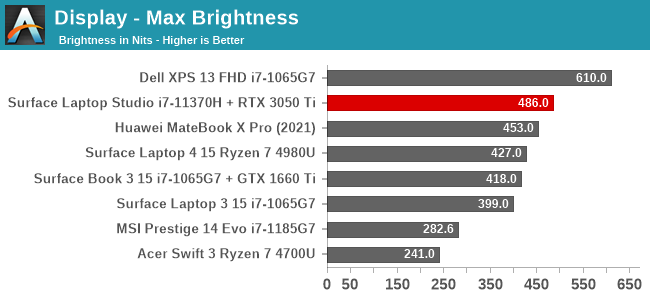
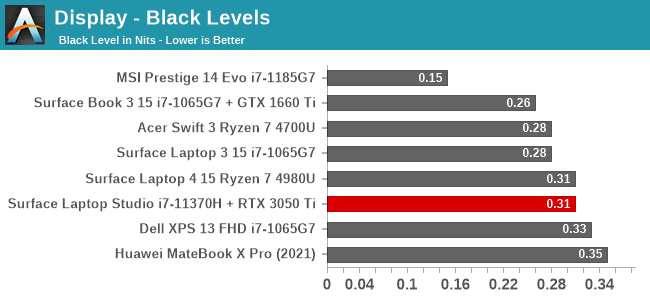
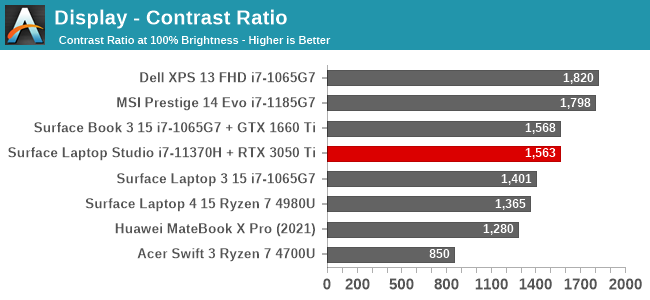
At 486 nits, the Surface Laptop Studio is not quite out brightest device tested, but it isn’t far off. The dynamic range of the display is also very impressive, with it achieving under 2 nits of brightness at its minimum setting. Contrast is also very good, although not quite as strong as some of the original Surface Book results which would be over 1800:1.
Grayscale

Microsoft is probably the only PC manufacturer to individually calibrate every display on every PC they sell, and the results are always impressive. Although the reds are slightly elevated, at no point in the grayscale test does the error level go above 3.0. Gamma takes a bit of a jump near 100% brightness, but the overall gamma is right on the 2.2 expected.
Gamut
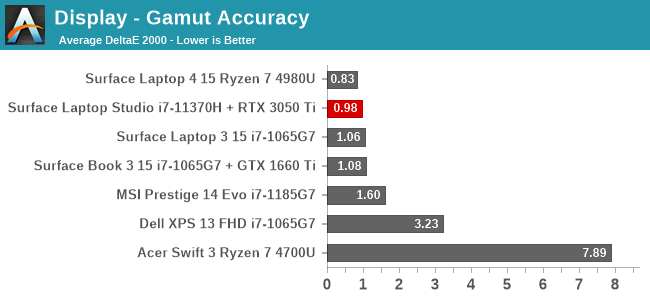
As already stated, Microsoft continues to target the sRGB gamut, but thanks to their individually calibrated panels, they target it nearly perfectly.
Saturation
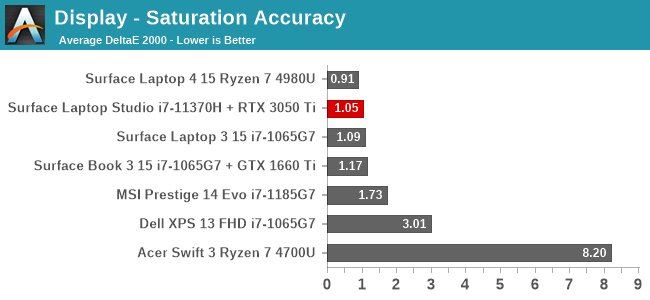
Where the gamut test focuses on the primary and secondary colors at 100% brightness, the saturation sweep tests the primary and secondary colors at 4-bit steps from 0% to 100%. The results are once again, nearly perfect.
Gretag Macbeth

Where the previous tests focus on just the primary and secondary color axis, the Gretag Macbeth colorchecker extends the testing to colors all over the gamut, including the important skin tones. Again, like most Surface devices, the color accuracy is fantastic.
Colorchecker
To give a graphical interpretation of the previous charts, the colorchecker test shows the targeted color on the bottom and what the display output on the top half of the swatch. Although there is some very slight deviations, the results are nearly perfect and would be undetectable to the human eye.
Display Conclusion
Although the Surface Laptop Studio does lose out on some display sharpness over the outgoing Surface Book, it more than makes up for that by offering a 120 Hz display which makes the entire experience more fluid. Like all Surface devices, the display is incredibly accurate for the sRGB gamut, and even if you use it in the vivid mode, which oversaturates the colors slightly, the accuracy in that mode is likely more accurate than almost any other PC on the market. Microsoft has nailed the calibration ever since they made a focus on display accuracy back in 2015, and it shows here again.
















53 Comments
View All Comments
nico_mach - Wednesday, October 6, 2021 - link
I don't think you'll get a clear statement from MS. That said, they indicated that this is the successor, so I wouldn't count on another Book release.And, yes, that is all they said, there is no definitive 'The Book is dead' statement anywhere.
Daeros - Tuesday, October 5, 2021 - link
Just curious as to why no comparisons were made to other ‘H’ sku offerings from Intel and AMD, or the Apple M1.It seems like a no-brainer that a CPU with >2x thermal dissipation and external GPU is faster than the ~15w platforms in this review.
Brett Howse - Tuesday, October 5, 2021 - link
Hi Daeros. I've not been sampled the Apple M1 in a laptop so it is not in our database.Most of the "H" series we've tested are bigger gaming systems with much larger GPUs. This is called an H35 but really it's more of a U-series with some headroom.
That being said, feel free to compare the Laptop Studio against any other device we've tested in our online Bench database here:
https://www.anandtech.com/bench/product/2890
ingwe - Tuesday, October 5, 2021 - link
So perhaps a stupid question: based on what I see from the battery life and charge time page, charging only happens through the Surface Connect port and not through Thunderbolt at all? Correct? If so, that is annoying as it means a normal Thunderbolt dock is next to worthless with this.Brett Howse - Tuesday, October 5, 2021 - link
The charger that comes with it is the normal Surface one but that doesn't mean you can't charge over the other ports.rogantastic - Wednesday, October 6, 2021 - link
I picked up my Surface Laptop Studio yesterday and confirmed you can charge with any standard PD charger over Type C on both ports, this is a requirement to be called "Thunderbolt" if less than 120 watts I believe (I could be wrong on the wattage number). I have a 65 Watt PD charger and it works GREAT.ikjadoon - Tuesday, October 5, 2021 - link
Excellent battery life for a 56 WHr 35W GPU + ~35W dGPU; these idles states are working well.And great to see, from the surface, a quite decent SSD (as I don't think SK Hynix makes QLC or DRAMless SSDs, do they?).
But, *quite* disappointed to see not a single type-A port and a silly, selfish omission. Following Apple's worse trends: "$1600 MSRP system with a dGPU and not a single USB type-A port."
//
The oddities are those browser benchmarks.
Either Windows 11, Edge, or some system timers are either beyond amazing or beyond borked. That 192 Speedometer 2.0 score for an i7-11370H (4.8 GHz Turbo) is 34% faster than AnandTech's CPU Bench all-time record of 143 by the i9-11900K (5.3 GHz Turbo).
Also would've liked an M1 comparison at least for battery life or CPU performance, though the main seller here is the hinged touchscreen.
ikjadoon - Tuesday, October 5, 2021 - link
* 35W CPU* Apple's worst
SirDragonClaw - Wednesday, October 6, 2021 - link
No one needs a old usb type-a port these days. Leaving it on would be foolish.alanh - Tuesday, October 5, 2021 - link
I find it curious that you talk about the new "unique hinge design" and then neglect to include any detailed pics of the hinge on the "Design" page.